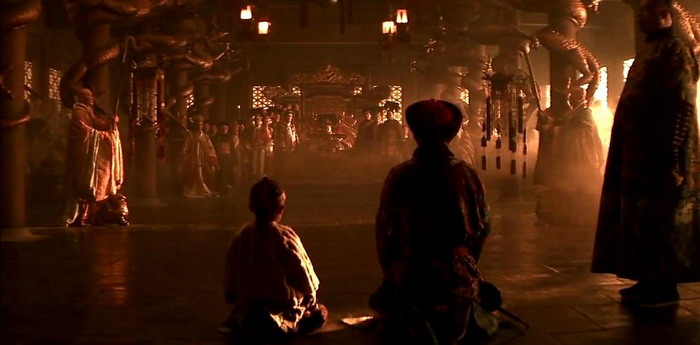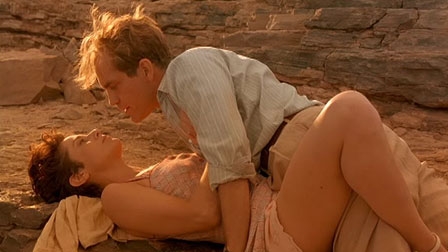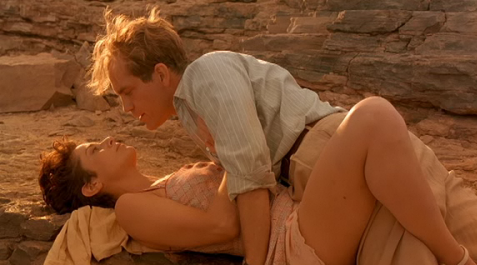From the Chicago Reader (January 25, 1991). — J.R.
THE SHELTERING SKY ** (Worth seeing)
Directed by Bernardo Bertolucci
Written by Mark Peploe and Bertolucci
With Debra Winger, John Malkovich, Campbell Scott, Jill Bennett, Timothy Spall, Eric Vu-An, and Paul Bowles.
Ever since the 60s the adjective “personal” has been frequently used in relation to commercial movies, and it has almost always been used as an expression of praise. As a reaction to the relatively “impersonal” directorial styles of a Fred Zinnemann, Stanley Kramer, or David Lean, the celebration of the “personal” styles of directors such as John Ford, Howard Hawks, and Alfred Hitchcock ushered in a critical bias that favored the director’s subjective involvement in his or her material — an involvement that is often autobiographical in its implications (such as Ford’s feelings for the Irish and the military, or Hitchcock’s sexual repression and his fear of imprisonment) — over the self-effacement that has often been regarded as both the norm and the ideal of conventional filmmaking.
But in order to argue that the films of supposedly “invisible” stylists like Hawks were highly personal, many auteurists wound up overstating their case, arguing in effect that any director with a discernible “personality” was automatically better than any director without one. Given the meager amount of recognition accorded in the early 60s to personal expression in commercial movies, that was an understandable and even defensible error. Yet their argument ruled out the possibility that certain films could wind up being so personal that audiences might be excluded from their principal meanings. Bernardo Bertolucci’s The Sheltering Sky is a prime example of this sort of problem. While it is a film full of mysteries — something I ordinarily like, regardless of whether they’re solved — the central mystery for me is why Bertolucci made it. That mystery, alas, tends to supersede all the others. Speculating on whether Bertolucci made the film in order to deal with some of his psychosexual problems seems both imprudent and unproductive, yet there is something about the film that throws me back onto such questions — something I ascribe to the more baneful influence of auteurism on me. For to assume that Bertolucci has no personal investment in the material would be to regard this movie as the handiwork of someone closer to Zinnemann than to Hitchcock — an even gloomier hypothesis to contemplate.
Many of my friends and colleagues regard Bertolucci’s last film, The Last Emperor, as impersonal, and they frequently allude to the blockbusters of David Lean by way of comparison. That’s an opinion I don’t subscribe to at all. For me, the personal side of Bertolucci is fundamentally bound up in a struggle to reconcile Freud and Marx — more specifically, a struggle to reconcile oedipal hang-ups with the precepts of Italian communism. It’s a struggle Bertolucci virtually inherited from his first mentor, Pier Paolo Pasolini (Bertolucci began as assistant director on Pasolini’s first feature, Accattone, and Pasolini provided the story for Bertolucci’s first feature, The Grim Reaper). It also forms much of the basis for his second feature, Before the Revolution, and most of his other films, including The Conformist, The Spider’s Strategy, 1900, and Tragedy of a Ridiculous Man. And it certainly is at the core of The Last Emperor, in spite of the fact that the film is set in China, Manchukuo, and Siberia rather than Italy.
I suspect that some people have resisted the idea that The Last Emperor is personal because of a half-buried bias against socially conscious films that originated in early American auteurism, a bias that still persists in many quarters. “The sociologically oriented film historians . . . looked on the Hollywood canvas less as an art form than as a mass medium,” Andrew Sarris wrote in his preface to The American Cinema (1969), the bible of auteurism. “Hollywood directors were regarded as artisans rather than as artists, and individual movies were less often aesthetically evaluated than topically synopsized.” There was enough truth in this charge to give Sarris’s “discoveries” — directors such as Hitchcock, Hawks, Sam Fuller, and Nicholas Ray, whom he was proposing were artists rather than “mere” entertainers or studio hacks — the force of a revelation. But that revelation came at the price of excluding most socially conscious films from artistic consideration.
“Thesis” cinema at its worst and least artistic was then represented by Stanley Kramer in the U.S. and Andre Cayatte in France; at its best and most artistic, it may well have included Ray. But the claims made by Sarris for Ray were strictly formal ones; insofar as Ray’s films were socially conscious, they were inartistic by definition: “Nicholas Ray has been the cause celebre of the auteur theory for such a long time that his critics, pro and con, have lost all sense of proportion about his career. Nicholas Ray is not the greatest director who ever lived; nor is he a Hollywood hack. The Truth lies somewhere in between. It must be remembered that They Live by Night, The Lusty Men, Rebel Without a Cause, and Bigger Than Life are socially conscious films by any standards, and that Knock on Any Door is particularly bad social consciousness on the Kramer-Cayatte level. His form is not that impeccable, and his content has generally involved considerable social issues.” It was only when Sarris took up Ray’s visual style, his romanticism, and his principal “theme” (“that every relationship establishes its own moral code and that there is no such thing as abstract morality”) — all of which were felt to be divorced from his social meanings — that he could find Ray’s work artistic.
“While I was editing The Last Emperor,” Bertolucci is quoted as saying in the press materials for The Sheltering Sky, “I suggested to (screenwriter) Mark Peploe that we go to Tangiers and meet Paul Bowles. I wanted my next film to be one with no immediate political or historical implications.” It’s his hard luck that The Sheltering Sky, which depicts the Arab world as wholly exotic and inscrutable — in direct contrast to his handling of China in The Last Emperor, which strove to make that culture and its recent history both legible and accessible — is being released when the U.S. is at war with Arabs. The possibility of The Sheltering Sky having “no immediate political or historical implications” is now just about nil. But even if we weren’t at war, the notion of setting out to make a film with no immediate political or historical implications doesn’t sound like the Bertolucci I know; it sounds like a Hollywood hack — or at least a director so intent on disavowal that he might as well be one.
These are harsh words, and I don’t mean to suggest by them that The Sheltering Sky is a movie devoid of serious meaning and interest. On the contrary, it’s probably Bertolucci’s most erotic and sensual movie since Last Tango in Paris, shot so gorgeously by Vittorio Storaro that it’s worth seeing for its views of deserts, markets, and North African alleys alone. While Bertolucci doesn’t take as much advantage of the hallucinogenic aspects of the book as he might have (Bowles was being introduced to a North African version of grass while writing the book), there are a couple of spots where he creates a striking moment of displacement during a character’s typhoid delirium, and there’s an effective disorienting series of camera movements when another character panics while racing down a village alleyway.
The film is also well acted by Debra Winger and John Malkovich — especially Winger, who seems incapable of giving an indifferent performance — even if they can’t transcend the limitations of the script and get us to care very much about them. They play Kit and Port Moresby, a wealthy couple traveling with seeming randomness through postwar North Africa, initially with an American acquaintance named George Tunner (Campbell Scott). And I certainly wouldn’t argue that the plot is uninteresting. Despite their deep emotional ties to one another, Port and Kit have been growing apart sexually; early in the story Port seeks out an Arab prostitute, and somewhat later, when Kit and Tunner are traveling alone on a train while Port rides in a car to the same destination, Kit allows Tunner to seduce her. Later, after Kit and Port contrive to separate themselves from Tunner (during a sort of Heart of Darkness progress south into the desert wilderness), Port becomes ill and dies in a delirious typhoid fever. The remainder of the story charts Kit’s growing madness as she willingly becomes the love slave of a Tuareg leader named Belquassim (Eric Vu-An), implicitly living out some portion of Port’s nihilist destiny.
Having recently read Paul Bowles’s novel for the first time, I found it very good if not necessarily great. Bowles is adept at landscape, atmosphere, and the sort of understated, poker-faced horror that is his specialty. The novel is ambiguous and suggestive about the central characters but formally interesting only for its occasional abrupt changes in narrative viewpoint, and it is limited as well as enhanced — that is to say, virtually defined — by the upper-class narrowness of the leading characters.
The novel has been hopefully linked by some critics to existentialism, the avoidance of psychology in the early nouveau roman, and the ethics and aesthetics of hip as propounded by the Beats. While none of these associations is exactly capricious, it seems excessive to label Bowles a major pioneer in any of these areas, with the possible exception of the third. (At best, he may have influenced such Beat writers as Burroughs and Kerouac, who knew him personally. But when it comes to existentialism and the nouveau roman, it’s worth recalling that The Sheltering Sky was published in 1949, seven years after Albert Camus’ The Stranger.)
If Hawthorne, Poe, Conrad, Stein, and Hemingway are among Bowles’s likely literary sources, another influence might be movies: “She opened the door. Port lay in a strange position, his legs wound tightly in the bedcovers. That corner of the room was like a still photograph suddenly flashed on the screen in the middle of the stream of moving images.” Curiously, a powerful scene that may be the most cinematic extended passage in the novel — Kit’s fearful journey across the fourth-class compartment of a train packed with Arabs, Berbers, and their belongings — is omitted in the film. Because this key scene provides both a major motivation for her succumbing to Tunner’s seduction (which occurs just afterward) and one of the most acute social commentaries in the book, its absence leaves a gaping hole.
In fact, I can’t really say that Bertolucci has enhanced the material in any way, apart from offering luscious illustrations for certain sections of it. Insofar as the film can be said to offer a “reading” of the book, it’s almost exclusively reductive, following most of the standard rules of Hollywood for simplifying acknowledged literary classics. To wit: 1. Make the leading fictional characters closer to their “real-life” counterparts. This is the sort of vulgar premise that can be found in such awful movies as Hemingway’s Adventures of a Young Man and Mishima, both of which combine biographical material and loosely autobiographical short stories by their authors in a manner designed to obfuscate the point at which “real life” ends and fiction begins. The idea is that we only read the fiction in order to learn about the authors’ lives — “personal” auteurism with a vengeance, albeit transferred to a literary mode. As a consequence, undoing the artistry of the artists becomes part of the process of getting the goods on them.
Bertolucci and Peploe haven’t traveled the full distance; they haven’t, for instance, made Kit Moresby a lesbian, as Jane Bowles was. But they have made her a writer like Jane Bowles, and they have made Port Moresby a composer like Paul Bowles, despite the fact that part of the identity of both characters in the book is that they don’t have artistic or professional identities; if anything, their lives are their art and their profession, and they conduct them accordingly. (Making them apparently frustrated artists, Bertolucci could be said to be supplying Freudian motivations for their behavior — one way of dealing with the material, although it’s at loggerheads with the novel’s intent.) A more interesting allusion might have been made to Bowles’s separate career as a composer if the film had used some of his music on the sound track; instead it has a routine, forgettable score by the once-interesting Ryuichi Sakamoto, who did effective work for Nagisa Oshima’s Merry Christmas, Mr. Lawrence (a film in which he also starred), but who has subsequently gone the dull route of Philip Glass in composing wallpaper film scores.
2. Tone down the sicko stuff. (a) For reasons that escape me — unless they’re part of some concealed personal agenda on Bertolucci’s part — Kit is much less neurotic in the movie than she is in the book, which makes her descent into madness less believable.
(b) Port and Kit keep running into a xenophobic and racist Australian woman (Jill Bennett) and her fat, whiny son (Timothy Spall), who keeps trying to borrow money from Port, supposedly because his mother won’t give him any. Late in the novel we’re informed that mother and son are sleeping together; Bertolucci tastefully leaves this creepy detail out.
(c) Eventually, after Kit has wandered off into the desert, Belquassim and an older man repeatedly rape her en route to Belquassim’s house, an outpost where she’s virtually kept prisoner. Bertolucci omits both the older man and most suggestions of rape; in the movie Belquassim at times almost treats Kit as an object of worship.
3. Add excess cultural baggage. Specific literary and film references that crop up in the film — an early upside-down close-up of Port that recalls the opening shot of Orson Welles’s Othello; a glimpse of Djuna Barnes’s novel Nightwood in Kit’s handbag; posters for a couple of French auteurist favorites, Max Ophuls’s Sans lendemain and Jean Gremillon’s Remorques — tend to be more decorative than meaningful. It’s true that part of Othello was shot in North Africa, that Nightwood deals in a baroque fashion with sexual and romantic frustration, and that Sans lendemain and Remorques are both love stories. But if this is all Bertolucci had in mind, dozens of other cultural artifacts might have served just as well. Apart from semignomic literary quotes that precede each of the novel’s three sections, Bowles’s novel got along nicely without such decor.
4. If the original is bleak, include a little ray of sunshine at the end. By the end of the book Kit is completely mad and vanishes in a crowded street; in the movie it seems as if she may be beginning to come to her senses. She wanders into a cafe where the major characters congregated earlier and encounters Paul Bowles himself — glimpsed and heard offscreen periodically throughout the film as a lone stranger reciting passages from the book. He asks her, “Are you lost?” After she replies that she is, he proceeds to recite, again offscreen, a passage that occurred in the form of dialogue between Port and Kit much earlier in the book. While the passage is effective enough in the novel, the film’s privileging of it as the last words smacks of sentimentality and pretension. (The flatness of Bowles’s voice is hardly the best way to serve his prose; the effect isn’t quite as grating as hearing William Faulkner read from The Sound and the Fury on records, but Bowles’s accent is sufficiently jarring — in part because it’s so different from the American accents of Winger and Malkovich — that it virtually ejects one from the movie.)
Admittedly, in the novel Kit might be said to come briefly to her senses when she recovers her use of language several pages before the end, but the novel hardly treats this as a hopeful sign: “In another minute life would be painful. The words were coming back, and inside the wrappings of the words there would be thoughts lying there. The hot sun would shrivel them; they must be kept inside the dark.” When Kit recovers language in a marketplace in the movie, the effect is merely banal and strained.
I fully concede that if I hadn’t read the novel before seeing the film, most of the above objections wouldn’t have occurred to me. But I suspect I still would have been faced with the nagging question of why Bertolucci wanted to make the film. Whether it’s so intensely personal that it can only be read as private or so impersonal that it can only be read as an industrial product is an issue that I feel unprepared to resolve. Maybe Bertolucci’s next feature will provide us with a clue.









